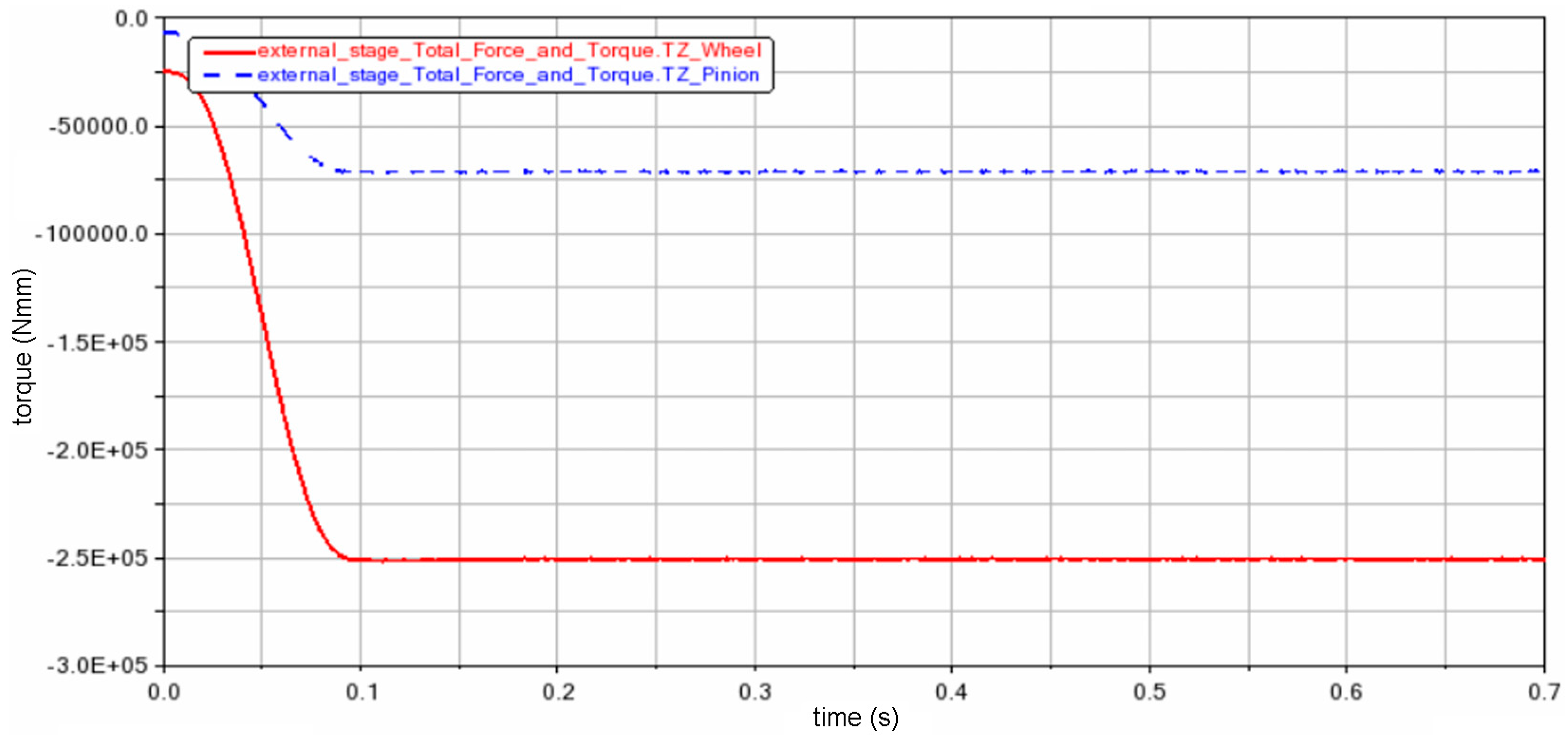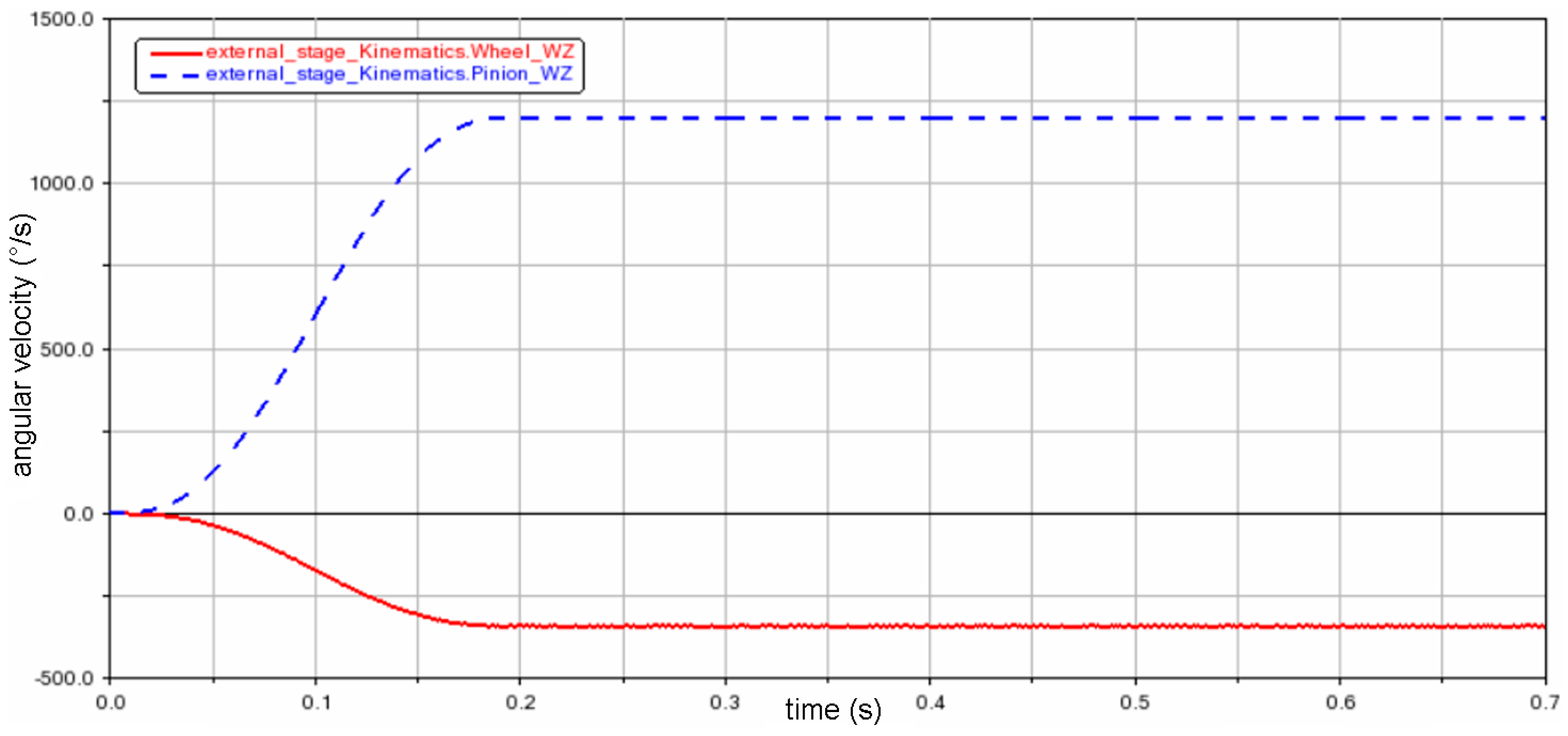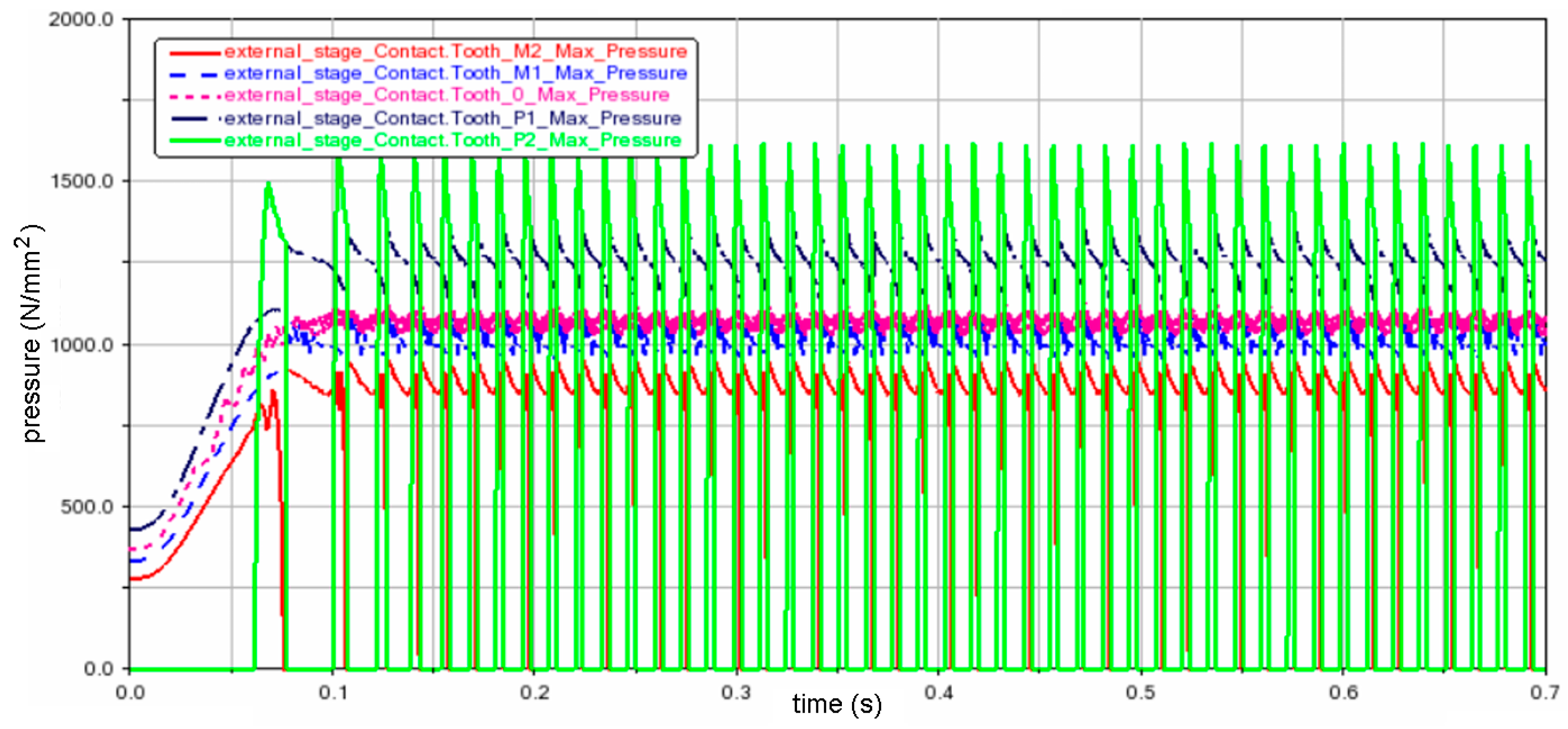Multibody Simulation of Helical Gear Noise and Vibration Behavior Using MSC ADAMS †
Abstract
1. Introduction
Research Gaps and Contributions
- Supports geometry optimization in the concept phase, before prototypes exist [4].
2. Methodology
2.1. Workflow Overview
2.2. Gear Geometry
2.3. Finite Element Flank Compliance
2.4. Drivetrain Assembly and Boundary Conditions
2.5. Solver Configuration
2.6. NVH Output Requests
- Torque time history for the wheel and the pinion;
- Angular velocity time history for the wheel and the pinion;
- Transmission error on the wheel side;
- Mesh-order spectrum in the form of FFT of TE from 0.2 to 0.4 s with a Hamming window (resulting in 2 Hz resolution);
- Maximum flank pressure on five adjacent teeth.
2.7. Tip Relief Sensitivity Study
3. Results
3.1. Torque and Speed Histories
3.2. Transmission Error and Mesh-Order Spectrum
3.3. Flank Pressure Distribution
3.4. Effect of Tip Relief Depth
4. Discussion
4.1. Transmission Error Control and Audible Benefit
4.2. Durability Versus NVH Trade-Off
4.3. Workflow Efficiency and Credibility
4.4. Model Limitations and Future Extensions
5. Conclusions
Author Contributions
Funding
Institutional Review Board Statement
Informed Consent Statement
Data Availability Statement
Conflicts of Interest
References
- Horváth, K.; Zelei, A. Simulating noise, vibration, and harshness advances in electric vehicle powertrains: Strategies and challenges. World Electr. Veh. J. 2024, 15, 367. [Google Scholar] [CrossRef]
- Zhou, J.; Wenlei, S. Vibration and Noise Radiation Characteristics of Gear Transmission System. J. Low Freq. Noise Vib. Act. Control 2014, 33, 485–502. [Google Scholar] [CrossRef]
- Wischmann, S.; Mann, A.; Jacobs, G.; Brecher, C. Validation of models for calculating the NVH behavior of gearbox systems in an elastic multibody simulation. Forsch. Ing. 2025, 89, 33–47. [Google Scholar] [CrossRef]
- Cianciotta, L.; Cirelli, M.; Valentini, P.P. Multi-objective optimization of gear design of E-axles to improve noise emission and load distribution. Machines 2025, 13, 330. [Google Scholar] [CrossRef]
- Shi, Z.; Liu, S.; Huijun, Y.; Wu, X. Noise analysis and optimization of the gear transmission system for two-speed automatic transmission of pure electric vehicles. Mech. Sci. 2023, 14, 333–345. [Google Scholar] [CrossRef]
- MSC Software. Creating a Single Helical Gear Pair [User Tutorial PDF]; MSC Software Corporation: Newport Beach, CA, USA, 2024. [Google Scholar]
- Zhu, X.; Huang, Z.; Shi, W.; Shi, L. Traceability and spectral analysis of transmission error in rotary vector planetary gear reducers. Appl. Sci. 2025, 15, 943. [Google Scholar] [CrossRef]
- ISO 6336; Calculation of Load Capacity of Spur and Helical Gears. International Organization for Standardization: Geneva, Switzerland, 2019.








| Parameter | Pinion | Wheel |
|---|---|---|
| Number of teeth | 23 | 81 |
| Normal module | 1.395 mm | 1.395 mm |
| Helix angle (β) | 24° LH | 24° RH |
| Pressure angle (α) | 20° | 20° |
| Face width | 30 mm | 20 mm |
| x (mm) | TE (µm) | ΔTE (%) | ΔSPL (dB) | pmax (GPa) | Δpmax (%) |
|---|---|---|---|---|---|
| 0 (baseline) | 0.25 | - | - | 1.65 | - |
| 0.05 | 0.205 | −18 | −2.0 | 1.75 | +6 |
| 0.1 | 0.173 | −31 | −3.1 | 1.88 | +14 |
Disclaimer/Publisher’s Note: The statements, opinions and data contained in all publications are solely those of the individual author(s) and contributor(s) and not of MDPI and/or the editor(s). MDPI and/or the editor(s) disclaim responsibility for any injury to people or property resulting from any ideas, methods, instructions or products referred to in the content. |
© 2025 by the authors. Licensee MDPI, Basel, Switzerland. This article is an open access article distributed under the terms and conditions of the Creative Commons Attribution (CC BY) license (https://creativecommons.org/licenses/by/4.0/).
Share and Cite
Horváth, K.; Zelei, A. Multibody Simulation of Helical Gear Noise and Vibration Behavior Using MSC ADAMS. Eng. Proc. 2025, 113, 36. https://doi.org/10.3390/engproc2025113036
Horváth K, Zelei A. Multibody Simulation of Helical Gear Noise and Vibration Behavior Using MSC ADAMS. Engineering Proceedings. 2025; 113(1):36. https://doi.org/10.3390/engproc2025113036
Chicago/Turabian StyleHorváth, Krisztián, and Ambrus Zelei. 2025. "Multibody Simulation of Helical Gear Noise and Vibration Behavior Using MSC ADAMS" Engineering Proceedings 113, no. 1: 36. https://doi.org/10.3390/engproc2025113036
APA StyleHorváth, K., & Zelei, A. (2025). Multibody Simulation of Helical Gear Noise and Vibration Behavior Using MSC ADAMS. Engineering Proceedings, 113(1), 36. https://doi.org/10.3390/engproc2025113036






